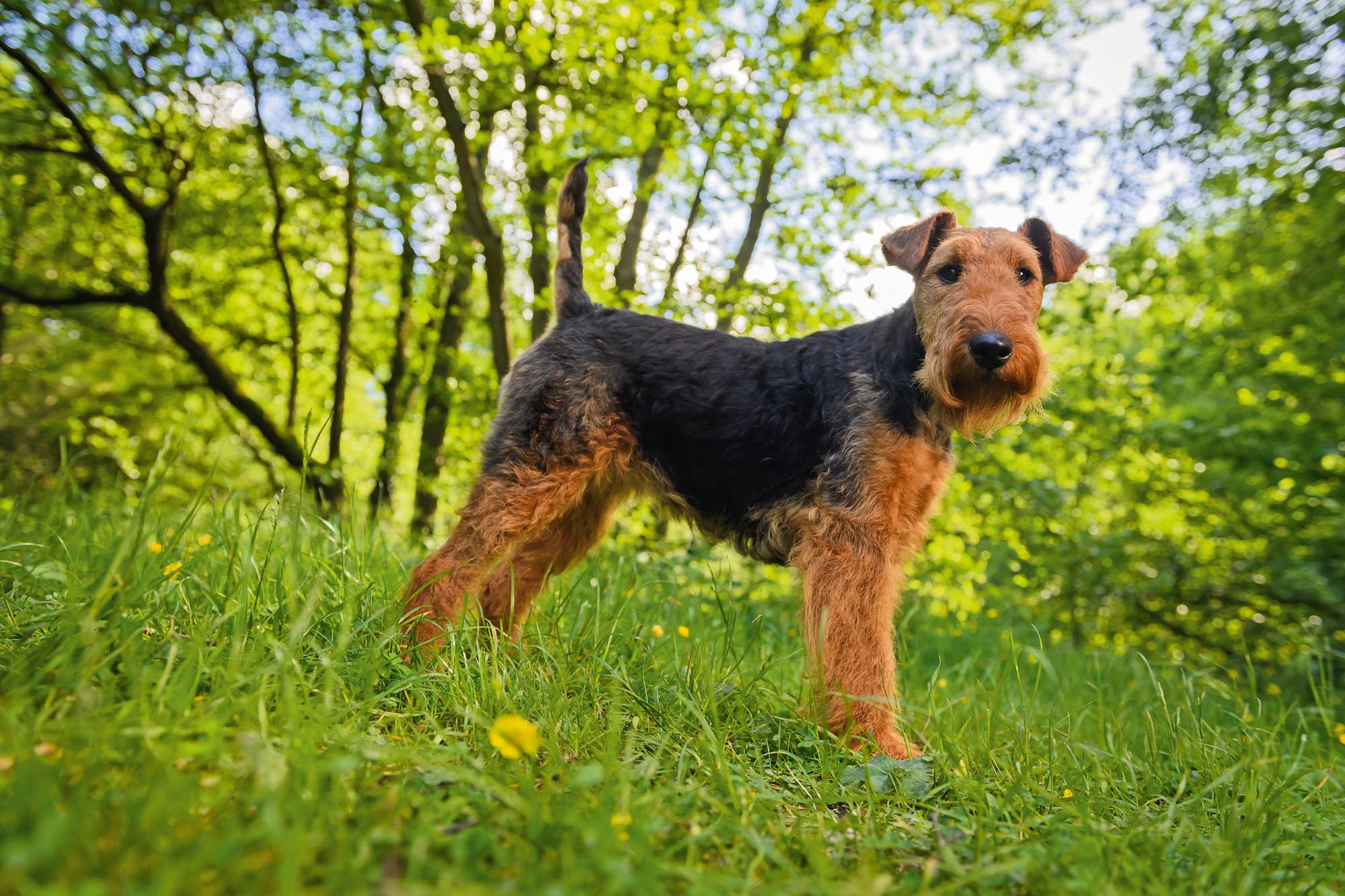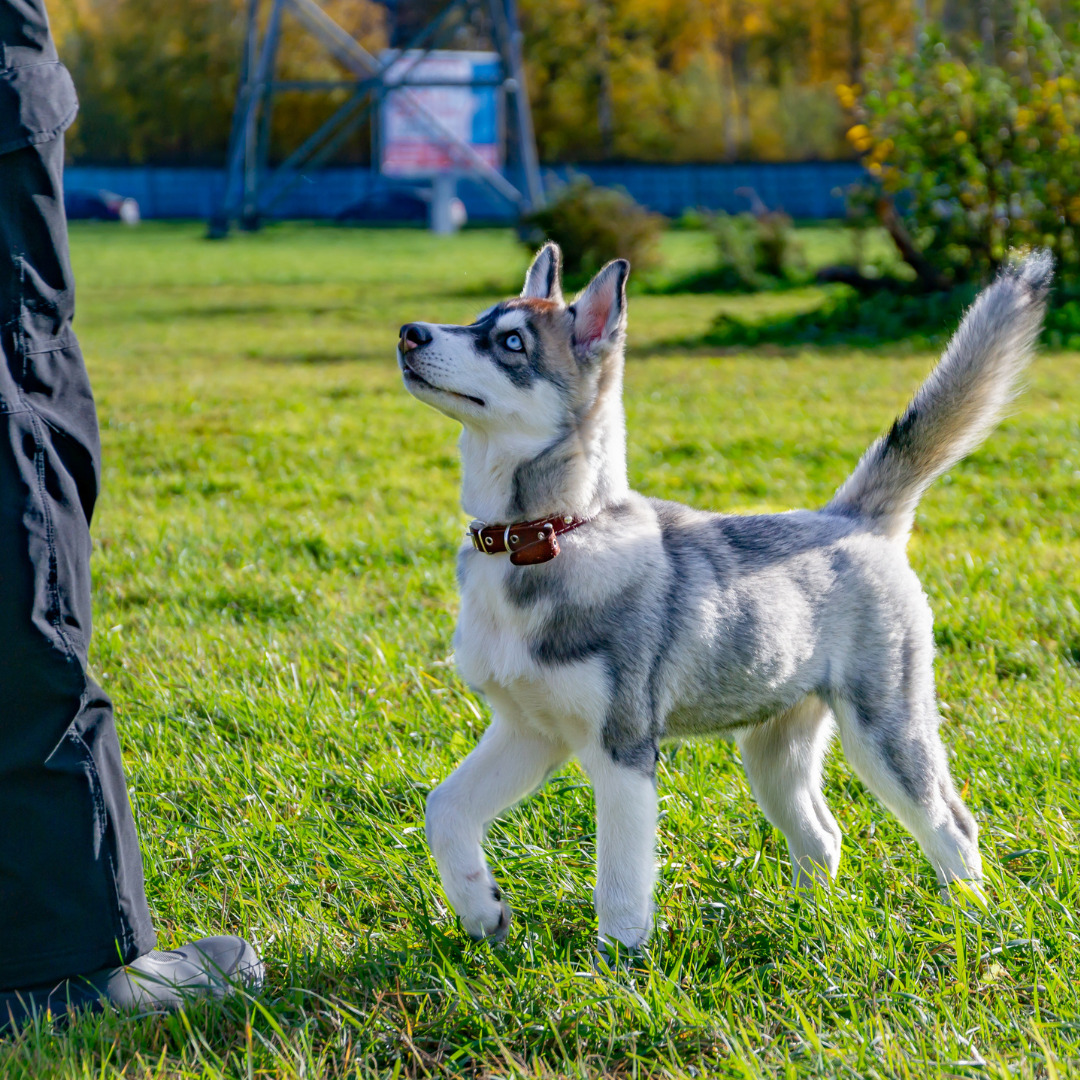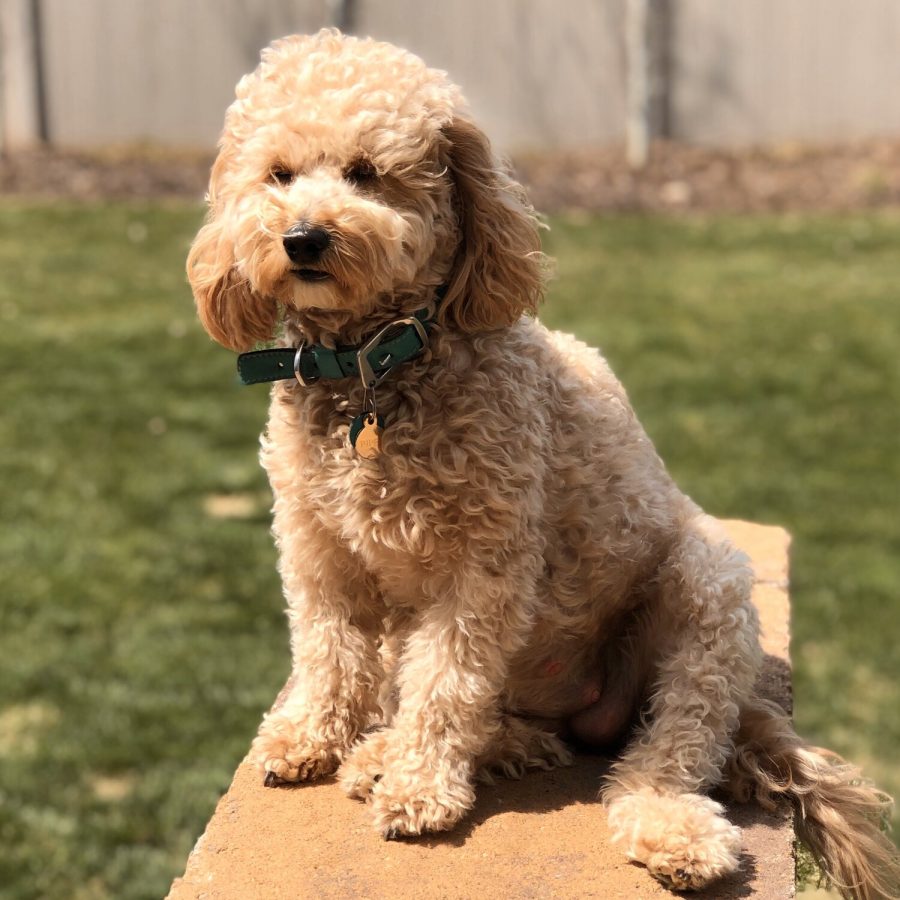The Welsh Terrier is an ancient breed with roots tracing back 500 years, known for its bravery in hunting badgers and vermin. Their fiery temperament and independence stem from their hunting background. These dogs are affectionate and protective towards their family, especially children. Welsh Terriers are playful and energetic, requiring mental and physical exercises. Grooming is manageable due to their low shedding coat, making them suitable for allergy sufferers. Their alert nature calls for mental stimulation and obedience training. Adaptability to various living environments with proper training. Discover more about this fascinating breed’s characteristics and care needs.
History
How has the Welsh Terrier breed’s historical presence shaped its evolution over the centuries?
The Welsh Terrier boasts a rich history dating back over 500 years, with records of its existence as early as 1450 and mentions in Welsh poetry from the 15th century. Evolving as a distinct breed in the 1700s, early references highlight the breed’s hunting prowess.
Bred for hunting purposes, Welsh Terriers were skilled at tracking and dispatching badgers, foxes, and vermin. Their relentless nature in pursuing prey, regardless of terrain, showcases their bravery and tenacity. Known for their powerful build, sharp jaws, and high prey drive, Welshies exhibit a distinct digging behavior, tossing earth back under their bodies while hunting.
Their fiery temperament, independence, and need for significant exercise are traits deeply rooted in their history as hunters. These characteristics have been passed down through generations, shaping the breed into the loyal, energetic companions we see today.
Affectionate With Family
Welsh Terriers are known to be affectionate and devoted towards their family members, displaying loyalty and love in their interactions. This breed’s affectionate nature makes them wonderful companions for families seeking a loving and loyal pet. Here are three key reasons why Welsh Terriers are known for their affection towards family:
- Cuddly Companions: Welsh Terriers love to cuddle up with their family members, enjoying physical touch and closeness. They often seek out affection from their loved ones and are happiest when spending quality time together.
- Playful Interaction: These dogs enjoy engaging in playful activities with their family, whether it’s a game of fetch in the backyard or a leisurely walk in the park. Their playful nature fosters a strong bond with family members and creates lasting memories.
- Emotional Support: Welsh Terriers are attuned to their family’s emotions and provide comfort and support during challenging times. Their affectionate demeanor helps create a nurturing and loving environment within the household.
Good With Young Children
When considering Welsh Terriers’ compatibility with young children, their temperament and behavior are significant factors to examine. Welsh Terriers are known for their loyalty and protective nature towards their owners, which can extend to children in the family.
While they are generally good with kids, it is essential to note that Welsh Terriers may exhibit some aggression towards other animals, so close supervision is recommended when they are around other pets. Their feisty personality and energetic nature can make them great playmates for children who are active and enjoy outdoor activities.
Proper socialization from an early age is crucial to ensure that Welsh Terriers develop positive relationships with young family members. With the right training and care, Welsh Terriers can form strong bonds with children and become cherished companions in family households.
Good With Other Dogs
Considering their loyalty and protective nature towards their owners and children, Welsh Terriers’ interactions with other dogs can vary based on their socialization and individual temperament. When it comes to their behavior with other canines, here are a few key points to consider:
- Socialization: Proper socialization from a young age is crucial for Welsh Terriers to learn how to interact with other dogs positively. Exposing them to different environments, people, and animals can help them develop good social skills.
- Individual Temperament: Each Welsh Terrier has a unique personality, which can impact how they interact with other dogs. Some may be more outgoing and friendly, while others might be more reserved or cautious.
- Training: Obedience training plays a significant role in how Welsh Terriers behave around other dogs. Teaching them commands and how to properly greet and interact with other canines can help prevent any potential issues during social encounters.
Shedding Level
How does the shedding level of Welsh Terriers compare to other dog breeds?
Welsh Terriers are considered to be a low-shedding breed, making them a great option for individuals who may have allergies or prefer a cleaner living space. Their wiry and hard coat, which is black and tan in color, sheds minimally throughout the year. This low shedding level means that Welsh Terriers require regular brushing and hand-stripping to remove any loose fur and maintain the coat’s health and appearance.
Compared to breeds that shed more profusely, Welsh Terriers are a suitable choice for individuals looking for a dog that doesn’t leave excessive amounts of hair around the house. While no dog is completely hypoallergenic, Welsh Terriers’ shedding level is generally manageable and lessens the amount of time needed for cleaning up loose fur. Additionally, their coat grooming frequency can be easily maintained with regular brushing and occasional hand-stripping sessions.
Coat Grooming Frequency
Maintaining the coat grooming frequency of a Welsh Terrier is essential for preserving their distinctive black and tan wiry coat. To keep your Welsh Terrier looking its best, follow these grooming tips:
- Regular Brushing: Brush your Welsh Terrier’s coat at least 2-3 times a week to prevent matting and remove dirt and debris. Use a slicker brush or a grooming glove to keep the wiry coat in top condition.
- Handstripping: This process involves plucking out dead hair from the coat to maintain the wiry texture. Handstripping should be done every 6-8 weeks to help the new hair grow correctly and maintain the coat’s characteristic look.
- Professional Grooming: Consider taking your Welsh Terrier to a professional groomer every few months for a trim and handstrip. Professional groomers have the expertise to maintain the breed’s specific grooming requirements and ensure your dog’s coat stays healthy and beautiful.
Drooling Level
To maintain the distinctive appearance of a Welsh Terrier, it is important to note that the breed typically exhibits a low drooling level. Unlike some other breeds that may drool excessively, Welsh Terriers are known for their cleanliness and lack of slobber. This characteristic makes them ideal companions for those who prefer a tidy and low-maintenance pet. Owners of Welsh Terriers can enjoy the company of a dog that won’t leave drool marks around the house or on their clothes.
The low drooling level of Welsh Terriers also contributes to their overall neat appearance. With minimal saliva production, grooming sessions can focus more on maintaining their wiry coat rather than cleaning up drool. This characteristic aligns with the breed’s historical background as working dogs in Wales, where cleanliness and efficiency were crucial traits. Therefore, for those considering a Welsh Terrier as a pet, the minimal drooling is a positive aspect to take into account when choosing a canine companion.
Coat Type
The Welsh Terrier breed is characterized by a wiry and hard coat that should be black and tan in color. This distinctive coat type requires specific care and maintenance to keep the Welsh Terrier looking its best. Here are three essential points to know about the Welsh Terrier’s coat type:
- Wiry and Hard Texture: The coat of a Welsh Terrier is wiry and hard to the touch, providing protection and insulation in various weather conditions. This texture helps the breed maintain its traditional appearance and withstand outdoor activities.
- Black and Tan Coloration: Welsh Terriers have a signature black and tan coloration on their coats, with the black typically being the dominant color and the tan appearing as markings on the eyebrows, legs, and under the tail. This color combination gives the breed a classic and distinguished look.
- Minimal Shedding: While Welsh Terriers are not considered heavy shedders, they do require regular grooming to prevent matting and maintain the wiry texture of their coats. Brushing and hand-stripping every 6-8 weeks are recommended to keep the coat in optimal condition.
Coat Length
When evaluating Welsh Terriers, the coat length plays a significant role in their overall appearance and maintenance requirements. Welsh Terriers have a double-layer coat consisting of a wiry and hard outer coat and a softer undercoat. The outer coat should be dense and close-lying, providing protection from the elements.
The coat length of Welsh Terriers is typically around 2 inches long, giving them a neat and tidy appearance. This medium-length coat requires regular grooming to maintain its texture and prevent matting. While Welsh Terriers are not heavy shedders, they do require hand-stripping every 6-8 weeks to remove dead hair and maintain the proper coat texture.
Regular brushing is also necessary to prevent tangles and keep the coat looking its best. Proper coat care is essential to preserve the characteristic black and tan coloration and ensure the Welsh Terrier’s coat remains healthy and functional in various weather conditions.
Openness To Strangers
Exhibiting a reserved demeanor, Welsh Terriers typically approach strangers with cautious curiosity. This cautious approach stems from their hunting background and instinct to assess new individuals. Here are three key points to understand about Welsh Terriers’ openness to strangers:
- Alert Observers: Welsh Terriers are keen observers and will often take their time to assess strangers before warming up to them. Their cautious nature makes them excellent watchdogs, as they are quick to alert their owners of any unfamiliar presence.
- Wariness Towards Unknown: Due to their protective instincts and natural wariness towards the unknown, Welsh Terriers may exhibit aloof behavior when encountering strangers. This behavior is a result of their innate need to ensure the safety of their family and territory.
- Potential for Socialization: With proper training and socialization from an early age, Welsh Terriers can learn to be more accepting of strangers. Positive interactions and exposure to various individuals can help them develop a more open and friendly demeanor over time.
Playfulness Level
A notable aspect of Welsh Terriers is their engaging playfulness, which contributes to their lively and charming demeanor. Welsh Terriers are known for their joyful and spirited nature, often displaying a high level of energy and enthusiasm during playtime. This breed enjoys interactive games and activities that stimulate both their physical abilities and their sharp intellect. Their playful demeanor makes them excellent companions for families with an active lifestyle or individuals seeking a lively and entertaining pet.
Welsh Terriers thrive on engaging in various play sessions, whether it’s fetching a ball, playing tug-of-war, or participating in agility exercises. Their playful disposition also extends to their interactions with children, as they often enjoy joining in fun and games with younger family members. It is important to provide Welsh Terriers with ample opportunities for play and exercise to help channel their energy positively and prevent any potential boredom-related behaviors. Overall, the playfulness of Welsh Terriers adds vibrancy and joy to their owners’ lives, making them cherished members of the family.
Watchdog/Protective Nature
Demonstrating a vigilant and protective instinct, Welsh Terriers are known for their keen awareness of their surroundings. Their watchdog nature makes them excellent companions for those seeking a loyal and protective pet. Here are some key points to understand their watchdog/protective nature:
- Alertness: Welsh Terriers are naturally alert and will notify their owners of any potential threats or unusual activities in their environment.
- Courage: Despite their small to medium size, Welsh Terriers possess great courage and will not hesitate to defend their family if they sense danger.
- Territorial Instinct: These dogs have a strong territorial instinct, making them proactive in guarding their home and loved ones against perceived intruders.
Owners of Welsh Terriers can find comfort in their pet’s protective nature, knowing that these dogs will stand guard and alert them to any potential dangers.
Adaptability Level
The Welsh Terrier breed showcases a notable level of adaptability in various living environments. They can adapt well to apartment living as long as they receive enough exercise and mental stimulation to keep them happy and healthy. Welsh Terriers are generally considered good for novice dog owners due to their adaptable nature and friendly disposition. However, it is important to consider neighbors when choosing a dog for an apartment, as Welsh Terriers can be vocal and may alert you to any disturbances.
When living in an apartment, it is crucial to establish clear boundaries and rules for your Welsh Terrier to follow. Focus on basic obedience commands, leash training, and crate training to ensure they understand how to behave appropriately in their new living space. Consistent training, patience, and love are key ingredients in helping your Welsh Terrier adapt to apartment living and thrive in their new environment.
Trainability Level
Welsh Terriers exhibit a high aptitude for learning and responding positively to training methods. Their loyal and loving nature, combined with their intelligence, make them eager learners. When considering their trainability level, it’s important to note the following:
- Quick Learners: Welsh Terriers are known for their ability to pick up commands and tricks swiftly. Their sharp minds and willingness to please their owners contribute to their quick learning abilities.
- Positive Reinforcement: These dogs respond best to positive reinforcement techniques during training. Reward-based methods, such as treats, praise, and play, work effectively in motivating Welsh Terriers to learn and obey commands.
- Consistent Training: Consistency is key when training Welsh Terriers. Regular, short training sessions focusing on obedience and mental stimulation are essential to reinforce good behavior and prevent stubbornness.
Energy Level
Coming from a breed known for their quick learning abilities and responsiveness to positive reinforcement, the energy level of Welsh Terriers is a notable aspect to consider when welcoming one into your home. Welsh Terriers are independent, feisty, and brave dogs that require significant physical and mental exercise to thrive. Their terrier-like characteristics shine through with their high energy levels, making them enthusiastic companions for active owners.
To keep a Welsh Terrier content and well-behaved, it is essential to provide outlets for their energy through challenges and activities that engage both their body and mind. Regular exercise routines and interactive play sessions are crucial to prevent boredom and destructive behaviors that may arise from excess energy. Engaging in various activities that stimulate their natural instincts and intelligence can help maintain a harmonious relationship with your Welsh Terrier and ensure they lead a fulfilling life as a beloved member of your family.
Barking Level
With a propensity for vocalization, the barking level of Welsh Terriers is a notable aspect that owners should be aware of. Understanding this breed’s barking tendencies can help owners manage their pet’s behavior effectively. Here are some key points to consider:
- Alert Nature: Welsh Terriers are naturally alert and vigilant, making them quick to bark at any perceived threat or unfamiliar noise. This inherent trait can make them excellent watchdogs, but it also means they may bark more frequently than some other breeds.
- Training Importance: Due to their tendency to bark, early training is crucial to teach Welsh Terriers appropriate barking behavior. Consistent training methods focusing on positive reinforcement can help curb excessive barking and encourage desired responses.
- Socialization Impact: Proper socialization can also play a role in managing a Welsh Terrier’s barking. Exposing them to various environments and experiences from a young age can help reduce anxiety-induced barking and promote a calmer demeanor in different situations.
Mental Stimulation Needs
The barking tendencies of Welsh Terriers reflect their alert and vigilant nature, which also plays a role in addressing their mental stimulation needs. These intelligent dogs require mental challenges to keep them engaged and prevent boredom. Providing activities that stimulate their minds can help prevent behavioral issues and promote a healthy, happy pet. Here are some ways to meet the mental stimulation needs of Welsh Terriers:
| Mental Stimulation Activities | Description |
|---|---|
| Puzzle Toys | Interactive toys that require problem-solving skills |
| Training Sessions | Obedience training and teaching new tricks |
| Scent Work | Engaging in activities that involve their keen sense of smell |
| Interactive Feeding | Using food puzzles or slow feeders for meals |
| Hide and Seek | Playing games that involve searching for hidden objects or treats |
Engaging in these activities regularly can help keep Welsh Terriers mentally sharp and content in their environment.
Conclusion
In conclusion, the Welsh Terrier, with its rich history and unique characteristics, remains a beloved breed despite facing challenges such as declining popularity and potential extinction.
Known for its loyalty, spirited temperament, and hardy health profile, this medium-sized terrier requires attentive care to thrive.
With its blend of charm and tenacity, the Welsh Terrier continues to capture the hearts of dog enthusiasts worldwide.




